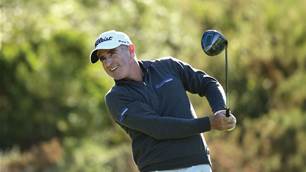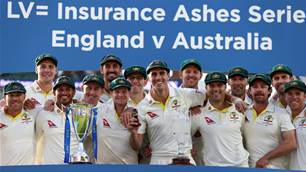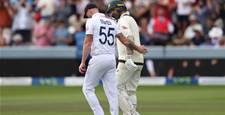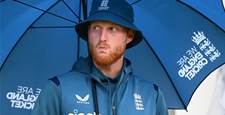While the cricketing world obsessed over tall quicks who dug the ball in and hit the bat hard, Fleming cantered in off a short run and bowled big hooping outies best viewed through sepia tint.
While the cricketing world obsessed over tall quicks who dug the ball in and hit the bat hard, Fleming cantered in off a short run and bowled big hooping outies best viewed through sepia tint.
As a cricketer, Damien Fleming was a throwback to more playful times. While the cricketing world obsessed over tall quicks who dug the ball in and hit the bat hard, Fleming cantered in off a short run and bowled big hooping outies best viewed through sepia tint. A hat-trick on debut in Rawalpindi, 75 Test wickets and a starring role in the ’99 World Cup triumph were his chief rewards for pursuing a style of bowling many thought dead. Off the field, Fleming’s penchant for banter, his proclivity for a gag and his love of rock music marked him out as a cricketer of the old school, a jovial fellow who stood apart from the flint-eyed hardness of the Steve Waugh years.
 photos by Getty Images
photos by Getty ImagesIn recent times the self-proclaimed “bowlologist” (he’s even got his own iTunes app) has carried all these characteristics into the Fox Sports commentary booth, bringing a good dose of levity, a strong shot of enthusiasm and a mind keenly attuned to seam-up bowling to the local scene. With a fresh Australian team, a new Test captain and a complete restructuring of the head office, we pulled up a stool and asked Flem to run his eyes over the state of the game in these parts.
Mate, a strong series win in Sri Lanka and early signs of form in South Africa: is it too early to be optimistic about the direction Australian cricket is heading?
Yep, too early. That Ashes series still hangs in my brain to be honest, big fella. To lose the series 3-1 ... I can sort of live with that. But to lose every one of those three Tests by an innings ... Look, we’re not that far behind England. If we’d lost those three Tests by a hundred runs or a couple of wickets, I reckon that would’ve been a fairer indication of the talent of the two sides. So until we play the next Ashes series – and hopefully regain the urn – I think there’ll be a bit of doubt and uncertainty around the place. At the moment we still don’t have a coach and we still don’t have a selection panel, so we’re certainly not out of the woods yet.
Yes, it was a good win in Sri Lanka, but if I was coaching Sri Lanka, I would’ve been very disappointed with the way they played. They massively under-achieved, while we showed we were hungry, we were smart and we played as a team. Those were the attributes that got us through and they’re the attributes we have to keep showing. We have to play with passion, we have to play smart cricket and if the opposition’s too good, well, good on ‘em.
Fair call. Let’s look at some of the talent. There are big wraps on Patrick Cummins. Can you run the rule over him?
 photos by, Getty Images
photos by, Getty ImagesWell, I call myself the “bowlologist”;I teach bowlology, and when you’re looking at a young bowler you go through a few categories.Firstly, there are his physical and technical skills. Then you find out a bit more about his tactical and mental whereabouts. Then you look at his performances; wickets and strike rates and the like. With Cummins, in last year’s Big Bash, straight away you said, “Gee, he’s tall and he’s got an athletic build. He’s got express pace, he bowls over 150. He has an excellent stock ball, his bouncer is quick, he has a good yorker, and he has a really good slower ball.” So you think, “That’s a decent little skillset for a 17-year-old!” Then we saw him in last season’s Shield final where he bowled a lot of overs, so you say, “Gee, he’s pretty fit.” Beyond that he was swinging the ball consistently, setting up players. I remember one over to Mark Cosgrove where he bowled three or four away swingers, then set him up for the big in-swinger. As I was watching him I couldn’t help thinking: how do you improve this kid? Seriously, for an 18-year-old, he’s got it all. My only concern with him is that at the end of last year he had a few little hot-spots showing in his back. But really, other than strengthening his body and getting him playing games and working out different scenarios, there’s not a lot to improve.
What about other youngsters like James Pattinson, Mitchell Starc and Josh Hazlewood?
Well, yeah, Cummins has definitely got some competition. I do rate these boys. And what I like most about them is that they’re absolute monsters. I think the smallest of them is six-foot-four and the others are six-six. And all of ‘em are 21 or younger. If they can keep improving, keep moving forward, I think we’ve got our next generation of fast bowlers pretty much sorted.
Andrew Hilditch looked so pleased with himself when he announced that Cummins had been called into the Test squad in South Africa. But I couldn’t help thinking of the gnarled 30-something quick who’s spent the last decade toiling away in Shield cricket. Are we forgetting these blokes? Are we becoming too obsessed
with youth?
No, I don’t think so. I mean, Cummins has got that wow factor, for all the reasons I explained before. He doesn’t need to improve that much. It doesn’t matter whether he’s 18 or 25 – his bowling looks international-standard to me. And I can’t think of too many guys going around who could feel unlucky that Cummins got picked before them. The only guy who could possibly feel hard done by is James Pattinson, who was in Sri Lanka, didn’t play, and has now seen Cummins go over the top of him. But I suppose the selectors’ thinking was that if James wasn’t going to be playing the Tests in South Africa, he’d be better off playing Shield cricket back here. Years ago when we went on tour, we’d be playing three or four tour games, so even if you weren’t playing in the Tests you were still getting exposure. Unfortunately it’s not like that anymore ... Look, I’m not that big on picking blokes on their age. You know, they picked Mike Hussey and Stuart Clarke at 29-30, and both had been conditioned in Shield cricket; they knew their games and they were ready to go. But that doesn’t apply to everyone. I think Ryan Harris has been absolutely superb so far in his Australian career. Peter Siddle’s another bloke who’s talked about improving his bowling. He’s been bowling a bit fuller, he’s got a wider grip on the ball, giving himself every chance to swing the ball. I also think Copeland’s been very steady, doing the job we all thought he would, being economical, drying up an end. If Mitch isn’t getting wickets, then these other blokes are lurking around.
What about Mitchell Johnson?
His Test bowling statistics are respectable, but he’s never really developed into a true spearhead of the attack. Will he ever make that step? Well, you’d have to think it’s doubtful. Spearheads of an attack are pretty rare – we’ve often had gaps in the lineage in Australia. You know, you go from Dennis Lillee, then there’s a gap to Craig McDermott, then Glenn McGrath took over the mantle, now we’ve got another gap. So it’s often the contribution of the fast bowling pack, as opposed to the efforts of one individual, that wins games. But those four young guys I mentioned before, I reckon any of those fellas have the ability to be spearheads ...But Mitch? He’s still too inconsistent, isn’t he? It’s unrealistic to think that a guy like that is suddenly going to turn it around and be a consistent bowler and lead the attack. What Mitch does provide, though, is that X-factor. That’s particularly valuable if the other three bowlers in the attack are good defensive bowlers, because it allows Mitch to let himself go and bowl the odd spell that can win a Test match. If the other guys are leaking runs, however, then Mitch’ll never be the sort of guy who’ll grab the ball like McGrath and bowl an economical spell that can change the momentum of a game.
Surely Ryan Harris is that ultra-reliable quick who can churn out the tight spell that turns the momentum of a match?
Yeah, his bowling’s reliable, but his body’s unreliable, isn’t it? He knows that, everyone knows that. So, in a three-match series, you just have to make sure he’s right for the first two Tests and helps you win there ... But what I really love about Ryano is his body language. He’s after the batsman every delivery. You know, he used to be a medium pacer hoping to be an all-rounder, but recently it’s all clicked for him. His pace is very good. He bowls that beautiful fuller length that commits the batsman to the stroke, and then he can shape the ball away. He’s a wonderful bowler. We need to maximise him before all these younger guys come through. He’s a bloke who really shows his team he wants the ball in his hand. But we’ve got to build other bowlers who can do that job because with his knee and his hamstring, I just can’t see him playing a lot of Tests.
In attitude, Peter Siddle’s a very similar bowler to Harris. He runs in hard, his first ball’s as fast as his last, he gives the team plenty of energy and heart. But where Pete needs to improve is his skills. Harris’ length is always full and testing, making the batsman hit on the up. Whereas Pete, particularly when he gets into trouble, bowls too short and gives the batsman too much time to play the ball. I was pleased to see in that last Test in Sri Lanka that he was trying to bowl a fuller length with a wider grip and wrist release to shape the ball away. You know, Sidds has been around for a while, but he’s not an old man. He’s only in his mid-20s, so I still see him as a long-term prospect as long as he keeps improving his skills.
Were you impressed with the way Michael Clarke used his bowlers on that Sri Lankan tour?
He was excellent for his first time in the gig, wasn’t he? I reckon it started in the one-dayers: his rotation of the bowlers was excellent, his field placements were clever and he was constantly talking to his bowlers, seeing what they wanted. That standard then carried through to the Test series. He seems to put a lot of confidence in his bowlers ... Massive tick for Clarke in his first series.
 photos by, Getty Images
photos by, Getty Images photos by, Getty Images
photos by, Getty ImagesEarlier you mentioned the current lack of a selection panel – did you put your hand up for the job?
No, I’m pretty happy just working in the media at the moment. What I do like about these new structures at Cricket Australia, however, is that there seem to be pathways for everything now. That new general manager job is an excellent example. That’s something for administrators to aspire to. To be the CEO of cricket in this country is an exciting role, a big role, and an important role.
I’m also happy to see that the chairman of selectors is now a fulltime role, so you’re going to get well paid to select the most important team in Australian sport. With a national talent manager in Greg Chappell and the various state talent managers, it’s a big job coordinating all their views. I think it would be a very exciting job to identify the next breed of Australian players, then work with the coach and the captain to get them into the Test team. I think it’s a far, far more appealing job now than it was when Andrew Hilditch was doing it part-time.
I’ve got a few concerns with the new coaching role, however. In some ways, the head coach role sounds like too big a job, to me. If you’re coaching all three forms of the game, you’re looking after the Centre of Excellence, and you’re trying to keep an eye on the states and their programs – I’m not sure one person can do all that. Maybe we need a head coach to look after the Test team, then the head of the Centre of Excellence could coach the one-day team, while the most successful state coach – the bloke whose team has won the Big Bash ‒ could look after T20 cricket ... It’ll be interesting to see what happens there.
Did Don Argus speak to you for his much talked-about report?
No, I didn’t get a gig on the review. But I’m very happy with what he’s come up with. You’ve got to get the structures right, then get the right people in. Things should happen from there. The word that was used in that report was “complacent”. I think we were dominating world cricket simply because we had great players; I don’t think our structures were as good as everyone thought. It just reiterated to me that the time to review things is while you’re doing well. Then, in the bad times, you don’t drop as low as we did.
Talking of structures, what about the traditional structure of players moving through grade cricket, into Shield cricket and then onto the Test team? Are we too reliant on academies and centres of excellence these days?
Nope, I think you definitely need these development programs and the various academies. I think the jump from grade cricket to state cricket’s too big, so I like the State Second XI competition. If the best grade players are only playing one and two-day cricket, then that Second XI comp exposes them to four-day cricket, while the academies upskill these blokes, giving them the ability to compete in state cricket as quickly as possible. So yes, I like the structures. We’ve just got to get the right people in these structures, working towards the one goal of getting us back to the top ranking in the Test, one-day and T20 formats. Of course, that’s easy to say, but it’s not always the easiest to get going.
Speaking of getting the right people on board, what are your thoughts on the selection of Pat Howard to the new general manager’s role?
Yeah, don’t really know much about Pat. Obviously an impressive union player who’s gone into administration at a young age. And that’s the thing that stands out to me – clearly he knows where he’s heading. It doesn’t really bother me that he’s never been involved in elite cricket, because I think it’s mainly about having that vision, about knowing where he wants cricket to go and about delegating the right roles to people who do know cricket.
You should put your hand up for the Wallabies’ coaching job ... Surely the theories of bowlology would transfer?
Well, you know, it’s not just about cricket, the old bowlology. It’s a life, it’s a business, it’s a sport, it’s absolute crap ... But I’m going to keep persisting with it, don’t worry about that!
‒ Aaron Scott
Related Articles

Video interview: Drinks With ... Matt Millar
19 Holes With... Damien Fleming













